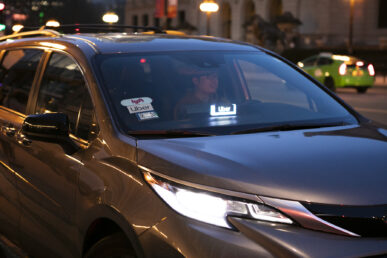One-third of ride-share drivers have had a crash on the job, survey finds
One-third of ride-share drivers surveyed in a new study reported being involved in a crash while working. Using a cellphone, driving while tired or driving on unfamiliar roads increased the likelihood of a crash, according to the study by University of Illinois Chicago researchers.
The study, recently published in the Journal of Safety Research, is the first the authors know of to quantify the frequency of crashes among ride-share drivers, according to lead author Brett Shannon, a doctoral student at UIC’s School of Public Health.
“It’s a relatively new profession, so there’s a lack of information around injury and morbidity in ride-share drivers,” Shannon said. The study looked at survey responses from 277 ride-share drivers who self-reported on their history of crashes and their driving behaviors.
While all drivers are at higher risk of a crash when driving while distracted or tired, ride-share drivers are uniquely susceptible to these conditions, the researchers said. They use their cellphones to get information about new passengers, for example, and they are often driving as a second job, which makes them more likely to be tired on the road.
But a bigger distraction for these drivers may be their customers, said coauthor Lee Friedman, a research professor in the School of Public Health.
“You’ve got a stranger entering your vehicle. They may be unruly. They may be drunk,” he said. Not only can something go wrong — the driver can crash or the passenger might get sick vomit in the backseat — but the driver likely is driving their personal car. This and other factors may add even more stress and distraction while driving.
The study was based on a small survey group, and the researchers have more studies in the works to explore the issue further. A grant from the National Institute for Occupational Safety and Health will allow them to conduct a more in-depth survey of ride-share drivers about their working conditions, in collaboration with the ride-share union. Another grant, in Australia, will fund the same survey there. The researchers also are gathering crash data from the Illinois Department of Transportation that will allow them to explore factors in ride-share crashes, such as weather, road conditions, who was in the car and what was happening just before the crash.
But even without the results of these additional studies, the authors say it’s clear conditions for these gig workers could be improved to increase safety for both themselves and their passengers.
Higher wages, for example, would mean drivers might work fewer hours and take more regular breaks, Shannon said. Further information is needed on psychosocial hazards including shift work, lack of task variety, ergonomic conditions, acute stressors like physical and verbal abuse from unruly passengers, poor job satisfaction and a lack of managerial support to understand stressors and distractions in this workforce. Additionally, providing more support for drivers who encounter unruly passengers could cut down on stress and, thus, distraction.
“There are a lot of issues around working conditions, work arrangements and the relationship between the company and the driver that could be addressed,” Shannon said.
The other authors on the study are Kirsten Almberg at UIC and Andrew Hellinger and Johnathon Ehsani at Johns Hopkins University.

